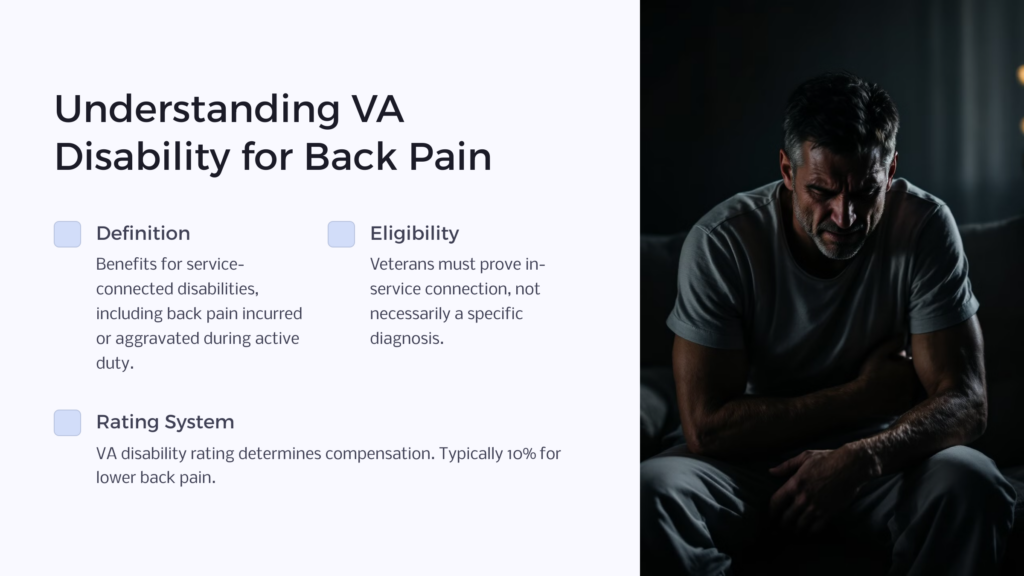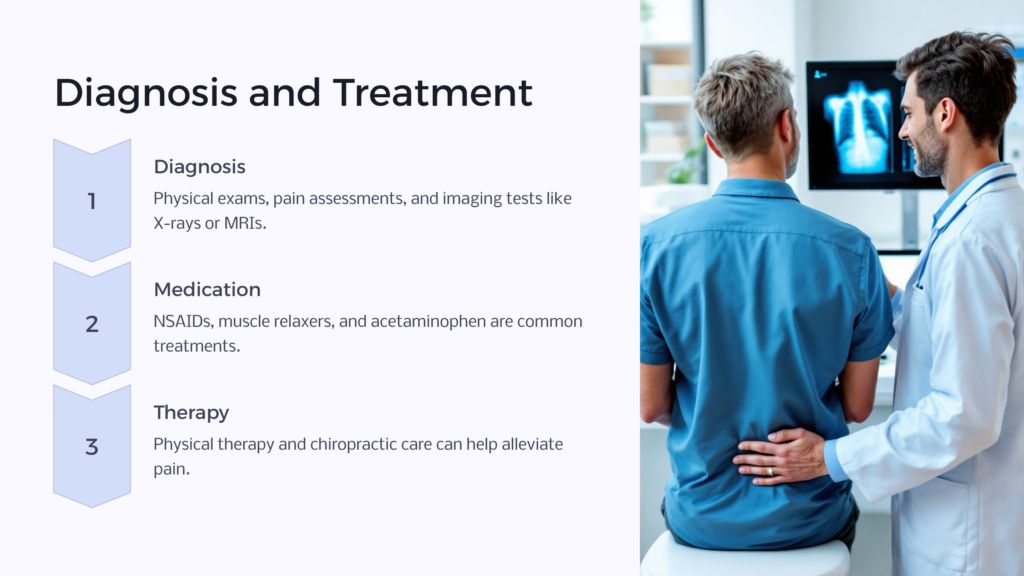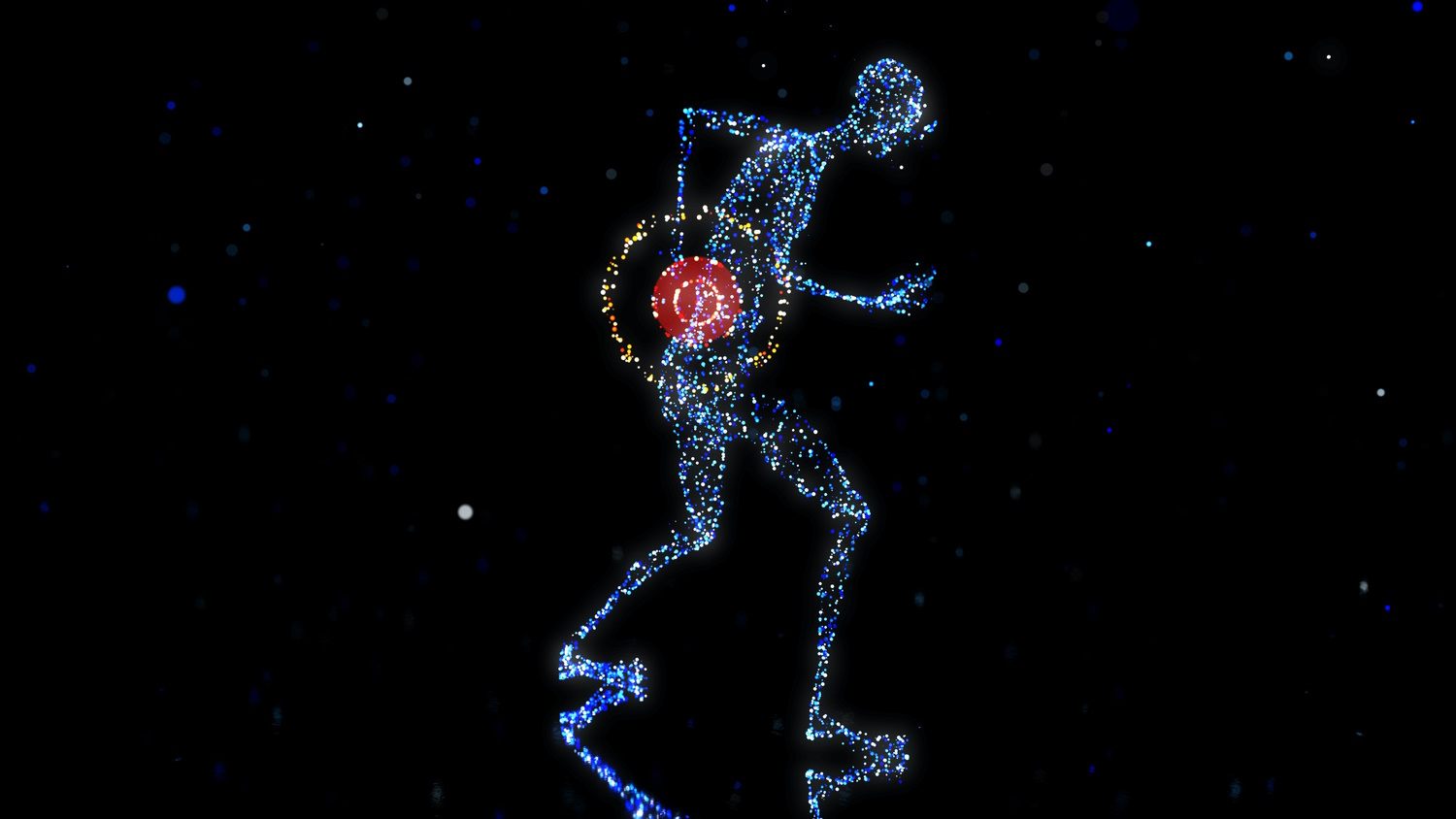If you are a U.S. military veteran and suffer from chronic or debilitating back pain — so much so that it prevents you from doing certain activities or working certain jobs — you may be eligible for disability for back pain.
However, there are certain requirements you need to meet before you can receive such disability benefits. Additionally, the amount you may receive will depend on the VA disability rating for your back pain. This may vary based on the severity of your condition or the type of back pain you may be dealing with. Medical records that support the severity and functional limitation of your back pain are important factors in your VA disability claim.
What Is Disability for Back Pain?

Disability for back pain is one of the many benefits you may be eligible for as a military veteran.
The Veterans Affairs office provides VA disability benefits for military service connected disabilities. This includes any disabling health condition or disease you may have incurred or aggravated while on active duty.
Aside from the VA, the Social Services Disability program also offers disability benefits for chronic back pain, provided the individual can prove it is a medically determinable impairment with medical evidence for their disability claim.
Many people still wonder whether chronic pain counts as a disability. A veteran’s chronic pain may be considered a disability if there are functional limitations, difficulty doing regular activities, and even difficulty within employment opportunities.
The more severe the pain and its overall effects are, the higher the VA disability rating a veteran can receive — and the higher their potential disability benefit compensation. In most cases, the VA rating for lower back pain is around 10%. However, the VA rating scale is based on individual disabilities, and the base score for a common disability doesn’t mean that is their final judgement of your disability benefit need.
Is VA Disability Commonly Offered for Back Pain?
Back pain is one of the most common health conditions limiting people’s ability to move and work. In fact, according to the CDC, back pain and other work-related musculoskeletal disorders are the number one cause of disability during working years.
Receiving VA benefits for back pain is not uncommon since many veterans suffer from back pain.
The U.S. National Institute of Health reveals that veterans are 40% more likely to suffer from severe pain. Veterans were also more likely to live with back pain, including back pain with sciatica than non-veterans.
Moreover, VA disability for back pain can be awarded to veterans even if they do not have a known back condition.
Unlike Social Security Disability benefits, which require the diagnosis of certain back injuries or conditions, veterans may be eligible for VA disability for back pain as long as they can prove an in-service connection instead of personal injury. This can be its cause, or the aggravation or worsening of an existing pain or condition.
Some may ask, “Is scoliosis a disability?” However, proving that the condition was either caused or aggravated during their military service is more important for VA disability compensation.
What Causes Chronic Back Pain?

There are various potential causes of chronic back pain. Muscle or ligament strain are common causes of back pain. These can be due to poor physical condition or posture and constant strenuous activity on the back.
Other causes of chronic back pain are:
- A fall or similar injury
- Myofascial pain syndrome
- Herniated, bulging, or ruptured discs in the spine
- Spinal stenosis
- Spondylitis
- Scoliosis
- Arthritis
- Osteoporosis
- Osteoarthritis
- Spinal fusion
- Sciatica
- Nerve root compression
- Degenerative disc disease
What Are the Symptoms of Chronic Back Pain?

The most common signs of back pain are muscle aches. This can be a shooting, burning, stabbing sensation, or a combination. Pain that starts at the back — usually along the spine and lower back — then radiates down the leg is also a symptom of back pain.
Other symptoms of chronic or debilitating back pain can include:
- Numbness or a tingling sensation
- Muscle spasm
- Weakness
- Difficulty walking
- Difficulty moving in general
- Need for additional lumbar support
How Is Chronic Back Pain Treated?
Chronic or acute back pain is typically treated with pain medication. According to researchers, the best medications for back pain are a combination of NSAIDs and muscle relaxers. Combining NSAIDs with acetaminophen was also found to improve low back pain greatly.
Popular examples of NSAIDs are ibuprofen, such as Advil or Motrin, and naproxen, like Aleve or Naprosyn. Meanwhile, brand names of acetaminophen include Tylenol and Panadol.
Aside from pain relievers and other medications, physical therapy and chiropractic care may also help alleviate lower back pain. However, surgery may also be necessary in severe cases, depending on the underlying condition causing the chronic back pain.
How Is Chronic Back Pain Diagnosed?

Chronic pain is generally diagnosed by assessing the individual’s ability to sit, stand, and walk. The physician may also examine your ability to lift your legs or objects. They will also physically examine patients’ backs and ask patients to rate their pain experience on a scale of zero to 10.
Digital imaging tests — like X-rays and MRI or CT scans — may also be necessary. For patients with suspected sciatica, compressed nerves, spinal stenosis, or herniated discs, nerve studies may also be ordered.
What Are the Best Exercises for Chronic Back Pain?
Exercise can help alleviate chronic back pain. Walking, swimming, and biking are all recommended activities for those with low back pain.
Low-impact aerobics are also good for chronic back pain. Stretches combined with core-strengthening exercises like Yoga poses and pilates are also very helpful in managing low back pain.
Some easy exercises you can do at home are:
- Bridges or the supine bridge
- Knee to chest stretch
- Partial crunches
- Child’s pose
- Cat camel
- Bird and dog stretches
What Resources Are Available for People With Disability for Back Pain?
Aside from guidance and resources from the federal or state government and the VA Office, non-government groups like Benefits.com offer reliable resources and knowledge for individuals looking into disability for back pain.
If you are eligible to receive benefits for sciatica, our team is here to help.
Benefits.com will gladly help you understand all your VA disability benefits more. In addition, our staff will work with you to determine your eligibility for specific benefits and whether you qualify for increased VA disability ratings.
Stay on top of your VA disability benefits and ensure you receive your due compensation. Visit Benefits.com today to get started with a free consultation.
 Benefits.com Advisors
Benefits.com Advisors
With expertise spanning local, state, and federal benefit programs, our team is dedicated to guiding individuals towards the perfect program tailored to their unique circumstances.
Rise to the top with Peak Benefits!
Join our Peak Benefits Newsletter for the latest news, resources, and offers on all things government benefits.




















